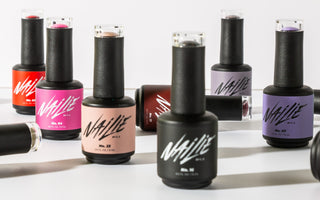Are you unsure about how to store your nail polish? There are many myths and misunderstandings that can create confusion about how nail polish should actually be stored. In this article, we will enlighten you on how to store nail polish correctly, ensuring that your nail polish does not go to waste and become unusable due to improper storage.

On the picture above, you can see a selection of gel polish, a type of Gel Polish colors from the brand Nailie. Photo: Nailie
Both nail polish and gel polish should always be stored correctly to maintain consistency, durability, color, prevent drying, and clumping. By storing nail polish correctly, you can ensure that it remains fresh, easy to apply, and in good condition for an extended period. This allows you to make the most of your nail polish products, including gel polish. After all, who wouldn't want to achieve beautiful nail polish results and avoid wasting them?
Read more: What is gel polish?
INCORRECT STORAGE OF NAIL POLISH
Let's start by addressing the various myths and misunderstandings surrounding nail polish storage. There are many myths that can actually do more harm than good and lead to incorrect nail polish storage practices. Here are the most common myths and misunderstandings about nail polish storage that you should avoid:
NEVER STORE NAIL POLISH IN THE REFRIGERATOR
Many people mistakenly believe that nail polish should be stored in the refrigerator to extend its shelf life. This is a myth. Nail polish should be stored at room temperature. The humidity in the refrigerator can negatively affect the consistency and durability of the polish. So, always avoid the myth of storing nail polish in the refrigerator.
DO NOT STORE NAIL POLISH IN THE FREEZER
Just like storing nail polish in the refrigerator, storing it in the freezer will undoubtedly damage the product. Storing nail polish in the freezer is entirely unnecessary. Extreme cold can alter the consistency and color of your nail polish. You also risk the bottle cracking or breaking due to the extremely low temperatures in a freezer. Therefore, avoid storing nail polish and gel polish in the freezer.
AVOID STORING NAIL POLISH IN THE BATHROOM
Some people store their nail polish in the bathroom, which may not be ideal in certain situations. The danger arises because bathrooms typically have high humidity levels. Moisture is one of nail polish's worst enemies, as it can change the consistency of the polish and make it thicker. While there may not be a high risk if you store it in a drawer or cabinet in the bathroom, to minimize the risk, consider finding a different place to store your nail polish.
CAN YOU STORE NAIL POLISH VERTICALLY?
Another myth is that nail polish should be stored vertically, i.e., upside down. While it is true that nail polish should be stored upright, there is a misunderstanding that bottles should be stored upside down. Avoid this practice, as it can allow air to enter the bottle and significantly degrade the polish. Bottles should be stored upright to prevent the nail polish from coming into contact with the cork.
AVOID STORING NAIL POLISH IN DIRECT SUNLIGHT
Nail polish should not be stored in direct sunlight, as UV light can affect the color and quality of the polish over time. It is best to store nail polish in a cool, dark place to preserve its properties and prevent it from hardening and clumping. Also, note that keeping the bottle near your UV/LED lamp while it is turned on and lit can cause the contents to harden.
WHAT TO CONSIDER WHEN STORING NAIL POLISH
Overall, there are some key points to ensure when storing nail polish and gel polish. By minimizing risks, you are more likely to extend the shelf life of your nail polish.
STORE NAIL POLISH AT ROOM TEMPERATURE
Always store nail polish at room temperature or slightly below. Avoid extreme temperatures, as they affect the consistency and durability of the polish. Also, avoid storing in direct sunlight.
ENSURE A TIGHT SEAL ON THE NAIL POLISH BOTTLES
Always make sure that nail polish bottles are tightly sealed. If bottles are not closed properly, air can enter, which can cause the nail polish to thicken or harden.
AVOID MOISTURE AND HEAT
Store nail polish away from places with high humidity, such as bathrooms, as moisture negatively affects the quality of the polish. Also, avoid storing nail polish near heat sources such as radiators or ovens, as heat can cause nail polish to harden and clump.
SHAKE THE NAIL POLISH BEFORE USE
It may be a good idea to shake the nail polish before use to mix the color pigments and ensure a smooth consistency. Be cautious when doing this, making sure that the cap is securely fastened to avoid accidentally spilling nail polish.
KEEP AN EYE ON THE EXPIRATION DATE
Like many other products, nail polish also has a limited shelf life. Therefore, keep an eye on the expiration date. If there is no expiration date, you can check if your nail polish is old. Signs that your nail polish is too old include separation, changes in consistency, and color. If it has expired, refrain from using it and purchase a new one instead.
WHY NAIL POLISH SHOULD BE STORED CORRECTLY
By storing nail polish correctly, you can ensure that it remains fresh, easy to apply, and in good condition for an extended period. This allows you to make the most of your nail polish products and achieve beautiful nail polish results.
It's important to note that nail polish has a limited shelf life, regardless of how it is stored. If your nail polish becomes thick, changes color, or develops an unpleasant odor, it's best to replace it, even if it has been stored correctly.